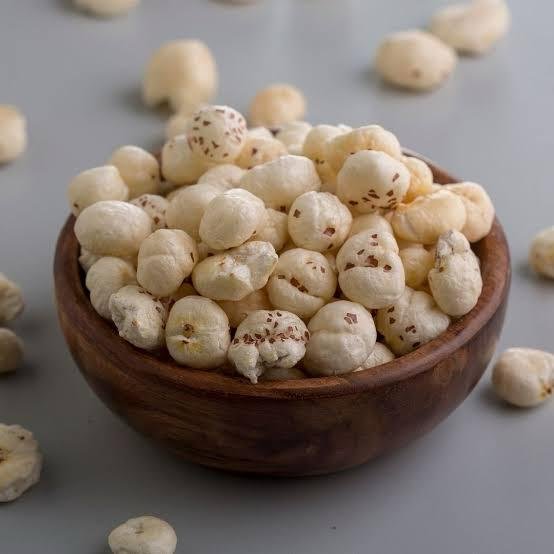
Ways to Enjoy Makhana
Makhana’s versatility in the kitchen makes it a beloved ingredient in both sweet and savory dishes. Here are some popular ways to savor this Mithila special:
Roasted Makhana:
- The simplest and most popular way to enjoy Makhana is by roasting it. Lightly roasted in ghee or olive oil and seasoned with a pinch of salt, roasted Makhana offers a crunchy, healthy snack that can be enjoyed anytime. You can also enhance the flavor with spices like turmeric, chaat masala, or black pepper.
Makhana Kheer:
- A classic Mithila dessert, Makhana kheer is made by simmering roasted Makhana in milk with sugar. The seeds absorb the milk’s flavors, creating a rich and creamy dish often garnished with nuts and saffron, perfect for festive occasions.
Makhana Curry:
- Makhana can also be incorporated into savory dishes like curry. Cooked in a spicy tomato-based gravy with vegetables like peas or potatoes, Makhana curry is a wholesome dish that pairs beautifully with rice or Indian breads.
Makhana Ladoo:
- For those with a sweet tooth, Makhana ladoos are a delightful treat. Made with roasted Makhana, jaggery, and ghee, these energy-boosting snacks are as nutritious as they are delicious.
Makhana Chiwda:
- A popular tea-time snack, Makhana chiwda combines roasted Makhana with peanuts, dried fruits, and spices, offering a mix of textures and flavors that’s both satisfying and healthy.
Makhana: The Nutrient-Rich Gem of Mithila
Makhana, also known as fox nuts or lotus seeds, is an integral part of the culinary and cultural heritage of Mithila, a region in Bihar, India. Revered for centuries, this ancient superfood is more than just a snack; it’s a symbol of tradition, prosperity, and health. Cultivated primarily in the wetlands of Darbhanga, Madhubani, and Sitamarhi, Makhana is not only a staple in the local diet but also a valuable agro-product that sustains the economy of the region.
Cultural and Historical Significance
The roots of Makhana cultivation in Mithila stretch back to ancient times, with the region’s unique environment providing the perfect conditions for growing the Euryale ferox plant. The nutrient-rich ponds and water bodies of Mithila have long nurtured this crop, making it a cherished part of the local culture.
In Mithila, Makhana is more than just food; it’s woven into the fabric of daily life and religious practices. During festivals like Chhath Puja, Makhana is offered to deities as a symbol of purity and devotion. Its use in traditional dishes during special occasions reflects the deep connection the people of Mithila have with this humble yet significant seed.
The process of cultivating and preparing Makhana is a communal effort, involving the entire community. From harvesting the seeds to sun-drying and manually popping them over high heat, the traditional methods have been preserved through generations, ensuring that the authentic taste and nutritional value of Makhana are maintained.
Nutritional Powerhouse
Makhana is not just a cultural treasure; it’s also a nutritional powerhouse. These small, white seeds are low in calories and fat, making them an ideal snack for those seeking a healthy lifestyle. Rich in protein, Makhana supports muscle repair and growth, while its high fiber content aids digestion and helps in weight management by promoting a feeling of fullness.
Packed with antioxidants, Makhana helps combat free radicals, reducing the risk of chronic diseases. Its anti-inflammatory properties and ability to regulate blood sugar levels make it particularly beneficial for individuals with diabetes. Moreover, Makhana is gluten-free, making it suitable for those with gluten sensitivities, and its low sodium content supports heart health.
Conclusion
Makhana, the prized agro-product of Mithila, is a true gem of Indian cuisine. With its deep cultural roots, nutritional benefits, and versatile culinary uses, Makhana is cherished not only in Mithila but across the globe. Whether enjoyed as a simple roasted snack or as part of a traditional dish, Makhana embodies the rich culinary heritage of Mithila, offering a taste of history, health, and tradition in every bite.

